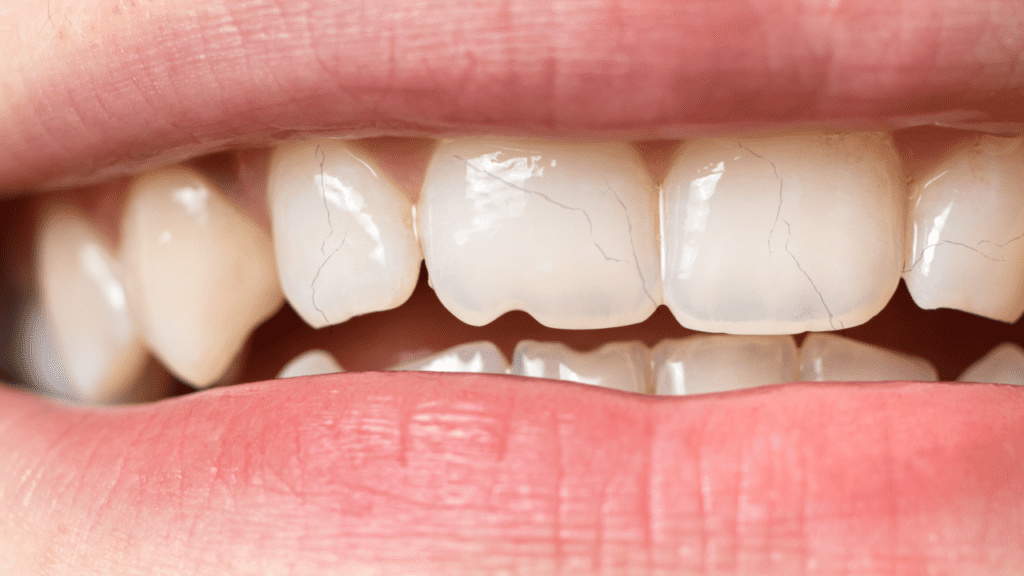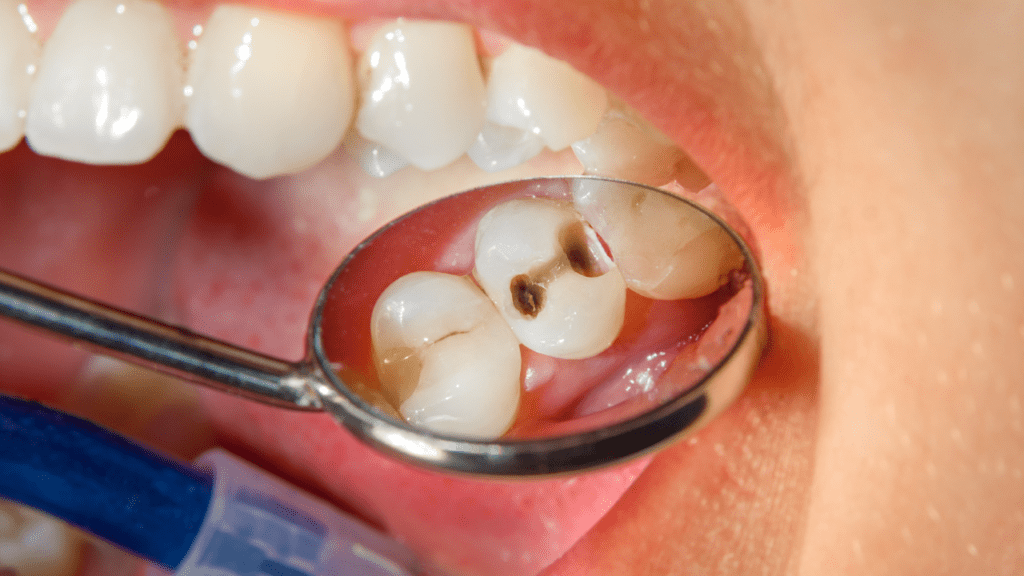White spots are sometimes difficult to see, but they are usually more noticeable when you smile. They can lower your self-esteem and make you feel self-conscious about your smile. Don’t worry; the spots are usually harmless and can be treated.
What Are White Spots On Teeth?
White spots on teeth can signify many things, but they are most commonly caused by dental fluorosis. This condition occurs when too much fluoride is ingested during the years when teeth are forming, resulting in white spots or streaks on the teeth. While dental fluorosis is usually not harmful to oral health, it can be unsightly, and many people seek treatment to improve the appearance of their teeth.
What Causes White Spots On Teeth
There are many reasons why you might have white spots on your teeth. Below are some of the most common causes:
Diet
Things like drinking coffee, tea, or red wine can cause white spots on teeth. This is because these beverages contain chromogens, dark-colored molecules that can adhere to your teeth and cause staining. Other dietary causes include eating sugary and acidic foods. Sugar can promote the growth of bacteria in your mouth, leading to tooth decay and enamel erosion. Acidic foods, on the other hand, can break down tooth enamel, making your teeth more susceptible to staining.
Fluorosis
Fluorosis is a condition that results from exposure to too much fluoride during tooth development. It can cause white spots, pits, or streaks on the teeth. In severe cases, it can even discolor the teeth. Fluorosis is more common in children because their teeth are still developing.
Although fluoride is good for dental health, too much of it can be harmful. It can happen if a child drinks water with too much fluoride or if they use fluoride products, such as toothpaste, that are too strong.
Enamel hypoplasia
Enamel hypoplasia is a condition that can cause teeth to become discolored, misshapen, and weak. It occurs when the enamel-forming cells in the tooth do not develop properly. This can happen due to genetic factors, certain illnesses or infections during pregnancy, or malnutrition. Enamel hypoplasia can affect both baby teeth and permanent teeth. Treatment options are available to help improve the appearance of affected teeth and to protect them from further damage.
Plaque Accumulation
Plaque can accumulate on teeth for a variety of reasons. Poor oral hygiene, not brushing or flossing regularly, can cause plaque to build up. Eating sugary or starchy foods also contributes to plaque formation. Drinking coffee, tea, or red wine can also lead to plaque formation.
White spots develop when plaque accumulates on teeth, and the bacteria in plaque begin to produce acids. These acids eat away at tooth enamel, causing demineralization of the enamel, or white spots to form.
Do White Spots On Teeth Go Away Naturally?
Unfortunately, for most people, the answer is no. White spots on teeth are usually permanent and will not go away on their own. They must be treated by a dentist to be removed.
Note that white spots affect the enamel of your teeth, which is the hard outer layer. Once the enamel is affected, it can’t heal on its own. You need to see a dentist to get it treated.
How To Treat White Spots On Teeth
You can do a few things to get rid of white spots on your teeth.
Enamel Micro abrasion
Enamel micro abrasion is a minimally invasive procedure used to improve the appearance of teeth. It can be used to remove white spots on teeth that are caused by fluorosis, tetracycline antibiotics, or other factors. The procedure uses a fine abrasive material to remove a small amount of tooth enamel.
After the procedure, your teeth may be sensitive to hot and cold temperatures for a few days. You will also need to avoid consuming staining foods and drinks, such as coffee and tea, for a while.
Enamel micro abrasion is generally an effective way to improve the appearance of teeth affected by white spots. The results of the procedure are usually long-lasting. However, it is important to maintain good oral hygiene habits and visit your dentist regularly to help prevent the spots from returning.
Professional Teeth Bleaching Or teeth Whitening
Teeth bleaching or teeth whitening is one of the most popular cosmetic dentistry procedures. It is a simple and non-invasive way to enhance your smile.
There are two main teeth bleaching types: in-office and at-home bleaching. In-office bleaching is performed by a dentist and involves using higher concentrations of bleaching agents than what is available for at-home use. This results in faster and more dramatic results.
When it comes to white spots, home bleaching is not as effective as professional bleaching. The main reason is that white spots are usually caused by a build-up of fluorides and other minerals on the teeth. These build-ups are difficult to remove with bleaching agents alone.
Therefore, professional teeth bleaching is the best option if you want to get rid of white spots on your teeth.
Topical Fluoride
A topical fluoride application is a great way to help treat white spots on teeth. This treatment involves putting a special gel or foam on your teeth containing fluoride. The fluoride helps to harden the tooth enamel, making it more resistant to decay. Topical fluoride applications can be done at your dentist’s office or home with a kit from your dentist.
Topical fluoride treatments are most effective when done regularly, so follow your dentist’s recommendations.
Composite Resin Bonding
Composite resin bonding is a popular treatment for white spots on teeth. The procedure involves using a tooth-colored resin to bond the materials to your teeth, effectively hiding the blemish.
The benefits of composite resin bonding include the following:
- The ability to match the resin to the color of your natural teeth, making it virtually undetectable.
- A quick and easy procedure can be completed in just one office visit.
- No need for anesthesia or drilling, making it a much less invasive option than other treatments.
- Affordable and cost-efficient procedure that typically only requires one dental visit.
The process of composite resin bonding is relatively simple and can be completed in just one office visit.
Dental Veneers
Dental veneers are one of the most popular cosmetic dental procedures. They are also one of the most effective ways to treat white spots on teeth. Veneers are thin artificial shells that cover your teeth’ front layer. They are usually made of porcelain and can be used to enhance and restore your teeth appearance.
Veneers will not only cover up the white spots on your teeth, but they can also improve your teeth’ shape, size, and color. They are an excellent option for people with stained or discolored teeth, chipped teeth, or gaps between them.
How To Prevent White Spots On Teeth
Preventing white spots on your teeth can be tricky, but it’s possible! Here are a few tips to help you avoid those pesky blemishes:
Increase brushing twice per day
The basic thing you can start with is to increase your brushing. You should brush at least twice a day and brush your teeth for two minutes. This will help to remove any plaque that might be building up on your teeth and causing the white spots.
Using a toothbrush with soft bristles is also important, so you don’t damage your teeth or gums while brushing.
In addition to brushing more often, you must also ensure you’re brushing correctly. This means using a pea-sized amount of toothpaste on your toothbrush and gentle circular motions.
You should also brush each tooth’s front, back, and top. And don’t forget to brush your tongue! This will help remove any bacteria that might be causing the white spots.
Reducing Sugar Drinks
Sugary drinks are an enemy to teeth, as the sugar combines with bacteria to form acids that can damage tooth enamel. Limiting how many sugary drinks you consume is best to help keep your smile bright and white. Here are a few tips:
- Drink water instead of sugary drinks: Water is the best choice for quenching thirst and keeping teeth healthy. It doesn’t contain any sugar that can harm teeth.
- Choose sugar-free drinks: If you drink sugary beverages, look for versions labeled “sugar-free” or “no sugar added.” These drinks still contain acids that can damage teeth, but they don’t have the extra sugar that can contribute to decay.
- Rinse your mouth with water after drinking sugary drinks: Rinsing your mouth with water after consuming sugary drinks can help remove some of the sugar from your teeth. This is especially important if you can’t brush your teeth after drinking.
Reducing Acidic Foods and Drinks
Acidic foods and drinks can contribute to the development of white spots on teeth. It’s best to reduce your consumption of acidic foods and drinks. This includes items such as citrus fruits, sports drinks, and soda. If you consume acidic foods and drinks, brush your teeth afterward or rinse your mouth with water to neutralize the acidity.
In addition to reducing your consumption of acidic foods and drinks, you can also help prevent white spots on your teeth by using a straw when drinking acidic beverages. This will help keep the acidity away from your teeth.
Use The Appropriate Amount of Fluoride
You can prevent white spots on teeth by using the right amount of fluoride. You need to discuss with your dental professional the frequency of fluoride consumption so you don’t get too little or too much..
Fluoride is found in many products, including toothpaste and mouthwash. It can also be found in some tap water. While fluoride helps to protect teeth from cavities, it can also cause white spots on teeth. If you are concerned about fluoride causing white spots on your teeth, you can use distilled or bottled water that does not contain fluoride. The water you drink, cook, and brush your teeth should not contain fluoride.
Fluoride can also be found in some foods and beverages. Fluoridated water is used to make many processed foods and drinks, including soda, beer, and wine. If you are concerned about fluoride causing white spots on your teeth, you can avoid these products or brush them after consuming them.
Using the Correct Amount Of Toothpaste
Toothpaste is key to keeping your smile looking its best, but you only need a little to get the job done. Using too much toothpaste can cause white spots on your teeth.
When you brush your teeth, only use a pea-sized amount of toothpaste on your toothbrush. Once you’ve put the toothpaste on your brush, brush gently so that you don’t damage your enamel or irritate your gums. Ensure that you use the right toothpaste.
When To See A Dentist
When you experience white spots, you should see a dentist as soon as possible. This is because the sooner you can identify the cause of the spots, the sooner you can treat them and avoid any long-term damage. If left untreated, white spots can lead to cavities or tooth decay.
Your dentist can determine the cause of your white spots and recommend the best treatment. Sometimes, they advise you to brush more regularly or use a fluoride mouthwash. However, your dentist may recommend a more intensive treatment plan if the spots are due to an underlying dental condition, such as enamel hypoplasia.
Don’t wait until your next appointment to see a dentist about your white spots. The sooner you seek professional help, the better your chances of avoiding serious dental problems.
Conclusion
White spots on teeth are not uncommon, but they can be a cause for concern. If you notice white spots on your teeth, it is best to see a dentist as soon as possible to determine the cause and get started on treatment. In the meantime, there are some things you can do to help prevent white spots from forming, such as reducing your consumption of sugary drinks and acidic foods and drinks. Brush your teeth regularly and use fluoride toothpaste to help keep your smile looking its best.
Healthline
Why Do I Have White Spots on My Teeth?
Medical News Today
Eleven tips to treat white spots on teeth
Mouth Healthy
Related Articles
What Are Teeth Craze Lines? Treatment, Causes & Prevention
Marcus Ramsey has been a professional writer for over seven years. He has talked about and produced content for industries like Dentistry, Healthcare, and more.
Erica Anand is a certified dental expert. She holds a BA in Chemistry and a Doctorate of Dental Surgery from Stony Brook University. After completing a two-year pediatric dentistry program, she now runs a private practice focusing on preventive dentistry and is a member of the American Association of Dental Consultants.






